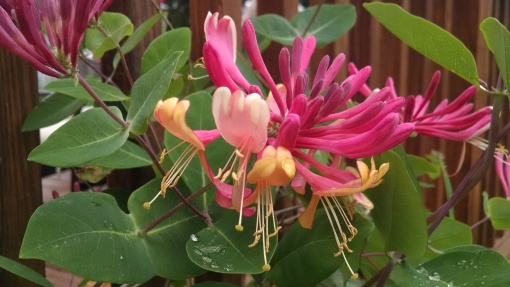Like many landscaped yards in Connecticut our property has boxwood adorning our front yard, planted more than 30 years ago. This shrub is usually a minimal maintenance woody ornamental plant. It requires a bit of shaping once a season even though its slow growth habit doesn’t send out the random foot-long shoots that its neighboring Japanese maple does. In fact, the amount that is trimmed off is more like a ‘shaving’ of its foliage and the easiest way to collect the clippings is to place a tarp beneath the shrub (the tiny pieces of leaf are almost impossible to rake it up). We tend to do the shaping of the shrubs in the landscape somewhere near the end of June and beginning of July. I remember one year (and I’m sure that my daughter will never forget) trimming them on a hot humid day where we ended up wearing bits of foliage that stuck to our damp skin!
Over Memorial Day weekend this year as I walked past the boxwood that borders our driveway I was surprised to see it covered in a white fuzz. I stopped in my tracks for a closer look. Up and down the stems and in the leaf axils was a fluffy white coating that dispersed like a powder into the breeze when I touched the shrub.

Using a macro lens, I took successively closer images until what looked like just white fuzz became individual clumps and then minute insects. These are the nymphs of the boxwood psyllid and the white fuzz was waxy strands of their crystallized honeydew secretions that is also called ‘lerp’. Yes, that is a real word. Boxwood psyllid (Psylla buxi) are in the family Homoptera, a suborder that also includes aphids, scale insects, cicadas, and leafhoppers.
The tiny orange eggs of the boxwood psyllid overwinter in the bud scales of the boxwood and will hatch when the temperature reaches 80 degree days, around the same time that the buds open. Degree days are an accumulative measurement that allow the prediction of insect appearances and plant blooming. For more info on degree days, visit the Cornell University site: Network for Environment and Weather Applications.
Enfield, CT reached 80 degree days on May 18th this year and between then and mid-June when we accumulate 300 degree days the psyllid nymphs will go through 5 instar (nymph) stages. They mature into winged adults as they finish their incomplete metamorphosis. It was a bit slower this year due to the cooler temperatures. The adults will mate and lay their eggs under the bud scales, there is only one generation a year.
Most of the damage from the boxwood psyllid is in the leaf cupping that happens as the larvae feed. They have sucking mouthparts and the leaves curl around the nymphs as they feed, a rather tell-tale sign of their presence. The psyllid doesn’t do any substantial damage.

Meanwhile, another pest also made its appearance. A beautiful Goldflame honeysuckle, Lonicera x heckrottii that adorns our deck was getting its yearly aphid visit.

As a relative of the boxwood psyllid the feeding damage of this aphid (Hyadaphis tataricae) is very similar. They love the flower buds and can feed inside the bud before you can even know that they are there. Aphid damage will stunt the growth of the flower buds and prevent the honeysuckle flowers from blooming.
And that would keep us from one of the pleasures of outdoor dining on a summer evening: watching the hummingbirds visit the showy pink and yellow tubular flowers as they search for nectar. The hummingbirds dart in and out so quickly but they occasionally stop for a brief respite, barely bending the vining stem as they weigh so little, often less than 1/10th of an ounce.
Bees and other pollinators such as the Eastern Tiger Swallowtail (Papilio glaucus) also spend lots of time going from flower to flower on the honeysuckle. It’s important to keep these visitors in mind when dealing with pests such as the aphids. A systemic insecticide should never be used during the period when a plant is flowering. These pesticides will target all insects that feed on the plant’s sap, drink the nectar, or gather the pollen regardless of whether they are beneficial or not.

A strong spray of water may dislodge aphids and psyllids or an insecticidal soap may be used. An insecticidal soap works as a contact pesticide and as such there is no residual insecticidal activity once the solution has dried. It must sprayed directly on the soft-bodied insects that it effectively controls. It also degrades quickly and will wash off leaf surfaces so that it won’t affect non-target insects, especially pollinators, or the lady beetles that consume the aphids in large quantities.

If you see (or have seen) psyllids or aphids you may want to do as I do and make a note of it in your calendar or your garden journal so that you can keep an eye out for them next year. Knowing when the aphids may show up on the honeysuckle gives me a bit of an edge in controlling them and allows the most blooms to come to fruition much to the enjoyment of humans, animals, and insects alike!
Susan Pelton
(all images and videos ©Susan Pelton, UConn Home & Garden Education Center)






May 23, 2021 at 3:51 pm
Thank you for this report. It enabled me to identify the fuzzy stuff (Psyllids) present on my box woods. I may spray the psyllids with water, but sounds like I don’t really need to to pursue with insecticidal soap. You description of the weather (temperatures) in relation to the observed “outbreak” matches our experience precisely. Thank you again for this report!
Jeff Borne,
Wallingford, CT